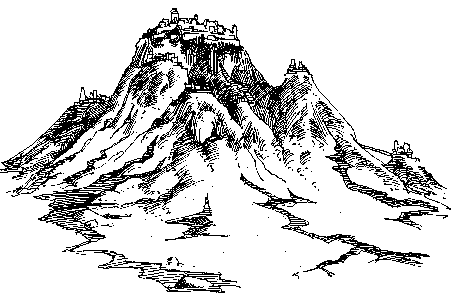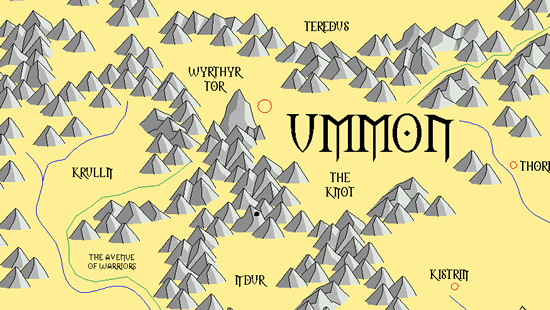|
The World of Teréth End - Gazetteer - Terèthor - Dekàlas |
||||||||||||||||||||||
|
Links Home "...[name] stood in the [name2] Hall, a hundred peers watching from the galleys above. She called her Provider's name, and all could feel the power she commanded. [name3] summoned his wards, but all that watched knew his efforts were in vain. The next name she offered was his, and the misery of [name3] was legend." translated from Dekàlan fragment found in ruins of Ilduùn |
Ummon Capital: City of Ummon
Since the time of Ruun, the Ummoni have settled the region's lowlands, no longer content with the security of mountain cliffs and high plateaus. Communities and farmlands have flourished in the once blood-soaked valleys. but the people remain ever-vigilant. With every provocation, troops march from Wyrthyr Tor (or from surrounding stations) to deal with Ortori and Uren marauders. All attacks are met with ruthless force often pushing invading forces back to their homelands where food stores and buildings are burned. In many areas this strategy of burnings would only incite the Ortor to do likewise to the communities of the Ummoni. But the Ortor are generally "considerate" of the farmers, in as much as they tend to leave farms intact so that they may be raided again the following year. The natives of Ummon are a fair-skinned people, with brown to tawny hair and light colored eyes. Their squattish frames set them apart from the rest of the Old Empire's people, and in ages past they have been dubbed the Dwürden of Dekàlas (one reason perhaps that it is not customary among Ummoni men to have beards). All members of Ummoni society serve in the military from ages 14-15, a service that is considered necessary for each person's religious indoctrination, necessary for the city-state's security, and necessary so that all people are well-versed in the ways of arms and armor should they later be needed for service. Though most are competent fighters, few peasants can afford swords. Caches of weapons however are maintained in most communities. D&D: This rigorously disciplined lifetstyle sets the peasants of Ummon at a higher level than those of other city-states. All adult peasants should be considered at least Com1/War1.
Pre-Dekàlan History The first inhabitants of the Land of Krulln came to the eastern high valleys along what is now the Western March. The journey must have been a perilous one for there is plentiful evidence that the region was inhabited by Ortor and Elve long before the Uren came to that area. Some have speculated that the Dwürden aided them in their march east from the ancient (by Uren reckoning) lands of westerm Terèthor. The Dwürden claim no knowledge of this. Early stories of the Krulln people tell of a guide from the Lone Mountain, which for many years was believed to be Wyrthryr Tor. Recently however, some sages have suggested that the peak may have in fact been Athalsyreel, deep within the Central Vale (known also as The Manless Lands, or the Lesser Anahl). If this is true, then the guide (if he ever existed) may not have been Uren, but more likely Elve or Faeri. Another question that arises is why a beneficent guide would lead a wayward people to Krulln, which is debatably the most hostile region within all of Terèthor. Others have guessed that the first Uren did not migrate at all, but were brought to the region as slaves for the Ortor. When the Dekàlans came to the area, the natives told stories that in the earliest times of their people there were great wars. The Krulln claimed that they were descendants of the last people to survive from that early time they claimed, the only others to survive were the Urkru, those that lived in The Knot (to the south and east). The Dekàlans of that time went to speak with the Urkru but soon left the people of The Knot alone, and have not returned there. The Krulln histories tell that there were hundreds of tribes that lived in the high valleys, and because resources were sparse there was much fighting between them. In the heaviest months of winter, the Ortor would swarm down from the high places and steal the stored foods and take women and animals back to their high snowy homes. Whole tribes disappeared (mostly from starvation) and it soon became apparent that the strength of numbers was the only way they might survive. So the many tribes became a few, and the few built walls around their communities and when the Ortor came they fought back with spears and knives and arrows. But the Ortor were fearless and stronger than the Uren tribesmen, and soon the pallisades were torn down, the food sotres were emptied, and the women were again taken away. For many years the Uren numbers dwindled, and the few tribes became one. In this time the Dwürden came to the tribesmen and shared with them powerful lore. Foremost among them was the lore of iron, so that the tribesmen could make better weapons and shields. Many of the tribesmen were skeptical (and even fearful) of the new lores and resisted the changes. One of these groups left the community and marched out into the mountain plains. These people were never seen again, but are believed to have been the Urkru. With weapons of iron and the training of the Dwürden the Uren survived the next winter, and the winter after that. Soon their population began to grow for the first time since the Ortor had come, for their women were not stolen away to the high places. Many years came and went, and the Uren numbers grew great once again, and their communities flourished behind walls of stone. In the centuries to follow the people of Krulln grew numerous and strong. Eventually, even the Ortor grew to respect their combat prowess and seek the fine weapons that they made. The people now worshipped a great god named Irul, who commanded that they protect their families and friends, but be merciless to their enemies. Under this guidance the warriors of Krulln began their own campaigns into the mountain high places, seeking the Ortor where they lived and burning their villages to the ground. The priests of Irul commanded that no Ortor remain so the females and children of the mountain people were also slaughtered to the last. The Ortor had never been attacked, so they had not been prepared, but there numbers were far greater than the Uren imagined, and now their bestial anger had focus. All that the Uren had gained and learned was to be put to the test as the great Ortori clans gathered and declared war on the Krulln. Details of Krulln-Murdru Wars are sketchy because they lasted for many years. During this time, the Krulln began construction of a citadel on the high mountain Wyrthyr Tor (circa 362 AR), built upon a more ancient fortress that existed in the peak (probably Dwürden, too little of the original tunnels remain to know). It cannot be said that the citadel was completed for it is still built upon today, but when the early walls were finished and the inner temple consecrated to great Irul na Krulln, the people of Krulln believed for the first time since the Day of the Hundred Tribes that they would survive in this high mountain place; perhaps they would even thrive. The priest-king Tolor is said to have beheaded twenty Ortor to baptize the stairs of the temple. The baptismal stains remain to this day. Over four hundred years later, a ruler of a small island kingdom (Lanàdus) ordered an extroardinary warrior into the mountains beyond Kandal to conquer the distant lands of the Nuléun Vale and the distant Eldorn (Dekàlan name for uncharted regions thought inhabited or abandoned by the Elve). Ruun, a veteran campaigner, accepted his liege's command and led his armies through the Snaking Pass and into the Nuléun Vale. His armies pushed forward along the river despite great resistance from the indigenous people. In Wyrthyr Tor, reports returned about an unstoppable army was marching through Krulln, and leaving their outposts smouldering cinders in their wake. Armies were sent to meet the conquerers, but few returned. The priest-king Harak decreed that they had angered Irul, and that the god's own army had come to punish them. This pronouncement spread quickly through the ranks of the Krulln and the armies of Wyrthyr Tor stopped fighting. Ruun marched his armies past thousands of standing armies, their blades sunk into the ground in the symbol of surrender. At Wyrthyr Tor the panicking priest-king ordered his temple's High Guard to defend the citadel, which they did for two months. When finally Ruun's army punched through the citadel's defenses he found the priest-king Harak dead upon his throne (some tales claim suicide, others that Ruun battled to the very throne and defeated the priest-king). Ruun had gained great respect among the Krulln he had fought. After a day of prayer he sent messengers back to Lanàdus explaining that he would stay and take the throne of this faraway land. When Mordun II received word of this he was outraged. He stormed through the halls of Kryr Tremendum screaming and cursing the name of Ruun. When those close to the High King could stand no more of his tirades, the mad High King was seized and imprisoned deep within Lanàdus, and a new High King was chosen. Dekàlan History
Post-Dekàlan History The High Lady Narea Dasadruun (dah SAH droon) the Third descends from a long line of warrior rulers to have sat upon the Throne of Ruun. The rule of Narea III has been marked with endless battles with the surrounding Ortori tribes. In the last eighteen years the level of warfare has escalated to seige levels which are draining the city-state's food and supply reserves. No-one is sure what is sustaining this elevated level of friction with the Ortor, but many are wondering what the High Lady will do to preserve her lands against the unceasing onslaught. There are many whispers in the Hall of Wyrthyr Tor that the High Lady should ask for help, but no-one dares speak that suggestion for the no High Lord (or King for that matter) of Ummon has ever begged assistance from outside lands. It is considered by most to be acceptable, that the pride and traditions of the ancient Throne of Ruun should be upheld, even if the downfall of the this great city-state should be the price.
|
Places Avenue of Warriors Dekàlan Lands Azàlari
(of Zalan) Terèthori Lands Arduwu Geography Teréth End is a Dekàlan name meaning "Whole of the Land". This terrestrial world consists of five continents, Emer (The
Lost Isle) nine seas, Acentran
(Inner Sea) and three moons. Mamra (Green Lady) |
||||||||||||||||||||
|
Ref. PHB (Player's Handbook), © Wizards of the Coast |
||||||||||||||||||||||

